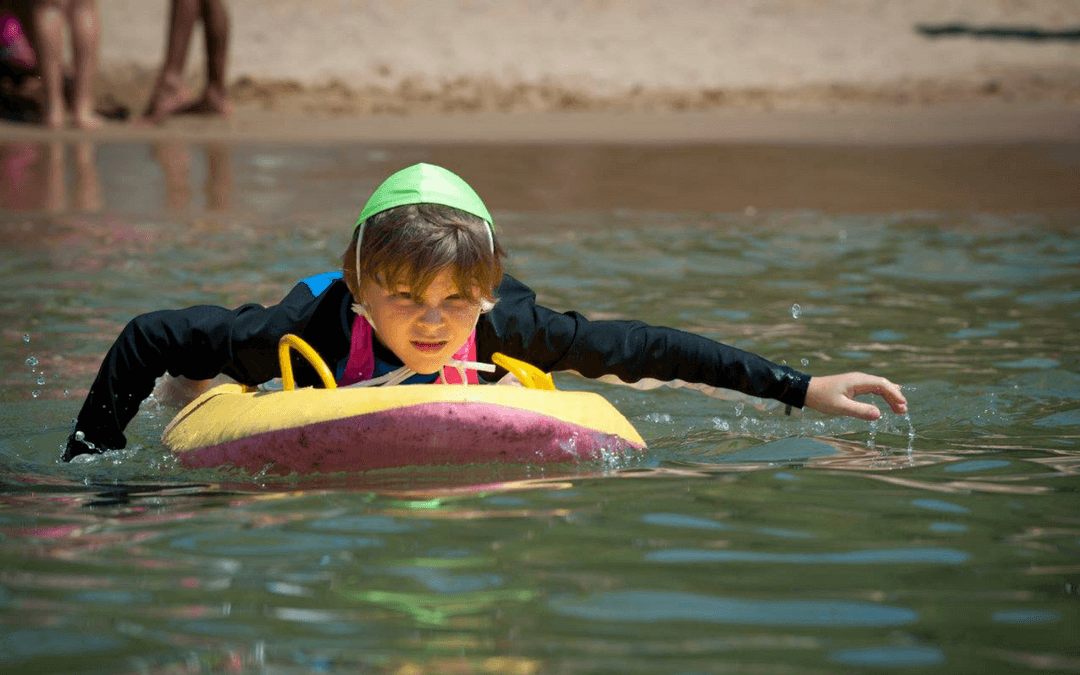Since Tropical Cyclone Debbie struck Australia last month, I’ve had quite a few concerned messages about extreme weather in Australia. When you’re watching the news from the other side of the world, it can be very difficult to comprehend what storms are really like in this part of the world.
If you’re planning on moving to Australia, the chances are that you want to choose somewhere ‘safe’ to live with your family. The fact is though that Australia is all safe, if you take care and take notice of alerts and warnings.
When we moved to Australia, I hadn’t really done any research into the weather here. I knew from experience that the further north we went, the hotter and more humid it would be. We picked north Brisbane for its sunny summers and its mild winters. We knew the heat would be extreme at times and we were prepared for that, but we didn’t really consider storms.
It hit home very quickly when a few weeks after arriving we were caught in a serious hail storm. We were safe and managed to get under cover quickly, but we were very lucky as it was a particularly bad storm. During our research, we’d planned schools, houses, health, insurance…all of the important stuff. But we never considered looking into what sort of extreme weather we could expect in Brisbane – I assumed that was something that happened in Port Douglas or Darwin – places up top, not South-East Queensland.

Cyclones in Australia
According to Geoscience Australia: ‘In an average season, tropical cyclones are mostly experienced in North-West Australia between Exmouth and Broome in Western Australia and in North-East Queensland between Port Douglas and Maryborough. In the Australian region, the official tropical cyclone season runs from 1 November to 30 April with most occurring between December and April. On average, about 10 cyclones develop over Australian waters each year and around six of these cross the coast.’
So if you move to the areas mentioned above, you are likely to experience more cyclone-force storms. That doesn’t mean you won’t experience severe weather outside those regions though. In our two and a half years, we have dealt with the after effect of Debbie and Tropical Cyclone Marcia in 2015. Back in 2015, our rental almost flooded by our side entrance as the sheer volume of rain that came down meant it had nowhere to drain between the side of our house and our neighbour’s. Lots of the roads around us flooded, and our kids’ school had to close. We haven’t actually suffered cyclone-force weather ourselves but the after effects of those storms brought very dangerous weather to wider parts of Australia.
Storms are now part of our life here. Not just big weather events like serious cyclones that you hear about on the news – there are many little storms too. Often they come and go in just minutes but they still have the power to be very destructive. The picture at the top of this post was taken a few weeks ago at my kids’ school after a short, sharp storm. This tree was big and solid – but the weather tore it down in minutes. It did some serious damage to the rest of the school grounds too.
Should you move to a storm-prone part of Australia?
If you want to live somewhere that is prone to storms, then don’t let extreme weather put you off. Just be sensible about things so you make informed decisions. Do more research into the town. What areas have flooded previously? What is the housing like and can you find a place that is likely to stand up to the harsh conditions? What do locals say in Facebook groups? Moving somewhere that is prone to very extreme weather and category force cyclones is a learning curve, and you just need to be prepared for it. You also need to learn what to do when a storm hits so that you’re prepared for it when it happens.
Cyclones usually hit the tropical north and west coasts, but the whole of Australia is prone to extreme weather at times. Where ever you’re moving, it makes sense to be prepared and your research.
Top tips for extreme bad weather in Australia
- If it’s flooded, don’t venture anywhere near it. It’s just not worth it.
- Be storm ready – maintain the trees around your property, make sure drainage is adequate around your property, have a flashlight and candles ready, have an emergency plan that everyone in your household knows about, stock some bottled water and tins – you’ll find lots of useful tips on the storm ready website.
- Watch the news and weather channels – keep an ear on how the weather system is changing and what this means for you.
- Make the decision whether to send your kids to school if you know bad weather is coming. With TC Debbie, Queensland’s schools were all closed for two days but I had already made the decision to keep my kids home. Ditto with TC Marcia, I kept my kids home and later on in the day the school was forced to close due to the weather but by then the roads all around school were closed due to flooding. If the weather is severe, don’t go out. Schools understand you’ve made a call based on a safety assessment and your instincts are usually right.
- If you don’t have a gas hob (or cooktop as it is called in Australia), get a portable gas stove in case the electricity goes out.
- If you have a pool, learn how to drain it as heavy rain can make it overflow (and if you’re on a hill this could flood a neighbours property, or it could even flood your own home). Every pool system is different, so don’t wait until a storm to learn how to do this (I speak from experience when ours almost overflowed from an unexpectedly heavy storm while my hubby was at work just after we moved in! Thank goodness for helpful neighbours!)
- Don’t go to the waterfront to watch the crashing ocean waves – you’re only putting yourself in danger and others who may have to come to help if you get washed in.
- Consider the location of your property carefully when buying a house. Research which areas flood locally – do nearby roads get cut off? Is there a creek nearby that often bursts its banks? Is the house at the bottom of a hill or a slope meaning all of the run-off water is going to head right to your house? Also, consider how solid the property is – are bits of roof likely to blow off in a bad storm? Does it look water tight?
- Link up with friends online – when bad weather is in full swing, it is comforting to know you have a support network nearby if you need help (or if you’re able to offer help back then you can be a comfort back for your friends too). When you’re far away from the help of family, it’s so important to know you have someone nearby to call on.
- If you can, park vehicles in your garage or undercover and avoid parking near trees.
- Clean your yard and deck from things that could blow around and cause damage.
- Be friendly with your neighbours – if there is a problem in your street it is good to know your community so you can stick together and help one another out.
- Make sure you’re stocked up on any important medications when you hear that a storm will be coming in case you can’t get out for a few days.
- Keep an eye on your local council website for updates, and make sure you are signed up to the council storm alerts.
- Remind your family that the number to call for emergency services in Australia is 000 NOT 999.
- Stay indoors – avoid going out if you possibly can until the weather has settled down.
Storm resources
Websites to bookmark:
Bom: The Bureau of Meteorology is the go-to site for weather warnings. When you hear people asking if you’ve heard the ‘bomb warning’, they mean this ‘bom’ not the other kind 🙂
Emergency Alert: Click through to find resources for your state.
Get storm ready: Check this site out for some simple ways you can get storm ready.
Google ‘storm alert’ for your chosen council area to find local alerts you can sign up to
Facebook pages worth following:
Higgins Storm Chasing
South Brisbane Storms (covers weather all around Australia)
Websites for your local State Emergency Service:
Queensland
New South Wales
Victoria
Western Australia
South Australia
ACT
Northern Territory
Tasmania
Sun safety

It’s not just cyclones that cause concern – the sun is another popular topic in my inbox…
Getting used to the heat in Australia is just as important as being prepared for bad weather. And when you hear statistics like two in three Australians will be diagnosed with skin cancer by the time they are 70, it is pretty scary stuff. The main things you need to be aware of with the extreme summers in Australia are: dehydration, overheating and skin damage/burning. Having a bit of knowledge and taking sensible care of yourself and your family members doesn’t need to be too tricky – it’s just a new thing you need to factor into your everyday life in Australia.
Top tips for sun safety in Australia
- Get a free skin check annually with your GP (our GP bulk bills with no gap fee which means this is a totally free service – you just strip down to your underwear and the doctor waves a light over you that highlights any abnormalities.) It’s something EVERYONE should do, so don’t make any excuses as it is FREE.
- Avoid being out during the middle of the day when the sun is hottest.
- Cover up with clothing where you can, even when you’re at the beach.
- Always wear a hat when you’re out in the heat, and encourage your kids to as well. Everyone in Australia wears hats so it’s not nearly as hard to get your kids to wear them as it was in the UK. Also, keep extra hats in the car for those impromptu trips or if your kids forget theirs on an outing.
- Wear high factor sunscreen – we only use factor 50 and we reapply it often. For the surf club nippers sessions (which often involves us being on the sand for over three hours by the time we’ve had a sausage sizzle afterwards), I use a zinc stick as well as regular sun screen.
- Wear sunglasses to protect your eyes.
- Take a beach tent or shade for your beach days, and don’t stay on the sand or in the ocean for too long (it’s easy to get carried away as you’re cool in the ocean but that is when you tend to burn the most).
- Always carry water with you – seriously, I always have a bottle in my bag nowadays and it always comes back empty. You never know when you’re going to be stuck in traffic for longer than expected or whether your kids are going to be thirsty when you collect them from school.
- Buy electrolyte sachets and ice poles – you buy the ice poles unfrozen from the chemist and then keep them in your freezer. They’re handy for when you’re little ones get a raging temperature, or they’re sick, or in case you’ve been exerting yourself outside and feel you’ve lost a lot of salt through sweating. When you’re getting used to the extreme temperatures, it’s worth taking these while your body gets used to its new normal.
- Buy a stack of UV sun shirts/rash vests in the sales at the end of summer for the year ahead. They don’t last long so you will need quite a few to get your little one through a summer season. I try to get long sleeved ones for the days when I know we’ll be out in it for a longer time.
- Keep bottles 3/4 full of water in your freezer and then top up the last 1/4 with tap water when you’re heading out. The ice will slowly melt meaning you’ve got a lovely icy drink to keep you going.
- Only take out food in cool bags/boxes (Eskys as they’re known over here) with ice blocks because food doesn’t last long in the heat. Also, remember to take your cool bags with you when you go shopping as it doesn’t take long for frozen goods to defrost in summer.
Australia really is a land of extremes. But it’s all good so long as you are prepared and you adapt to your way of life. Now, remembering our hat and water is just as important as remembering our scarf and gloves was back in the UK (even more so).
















